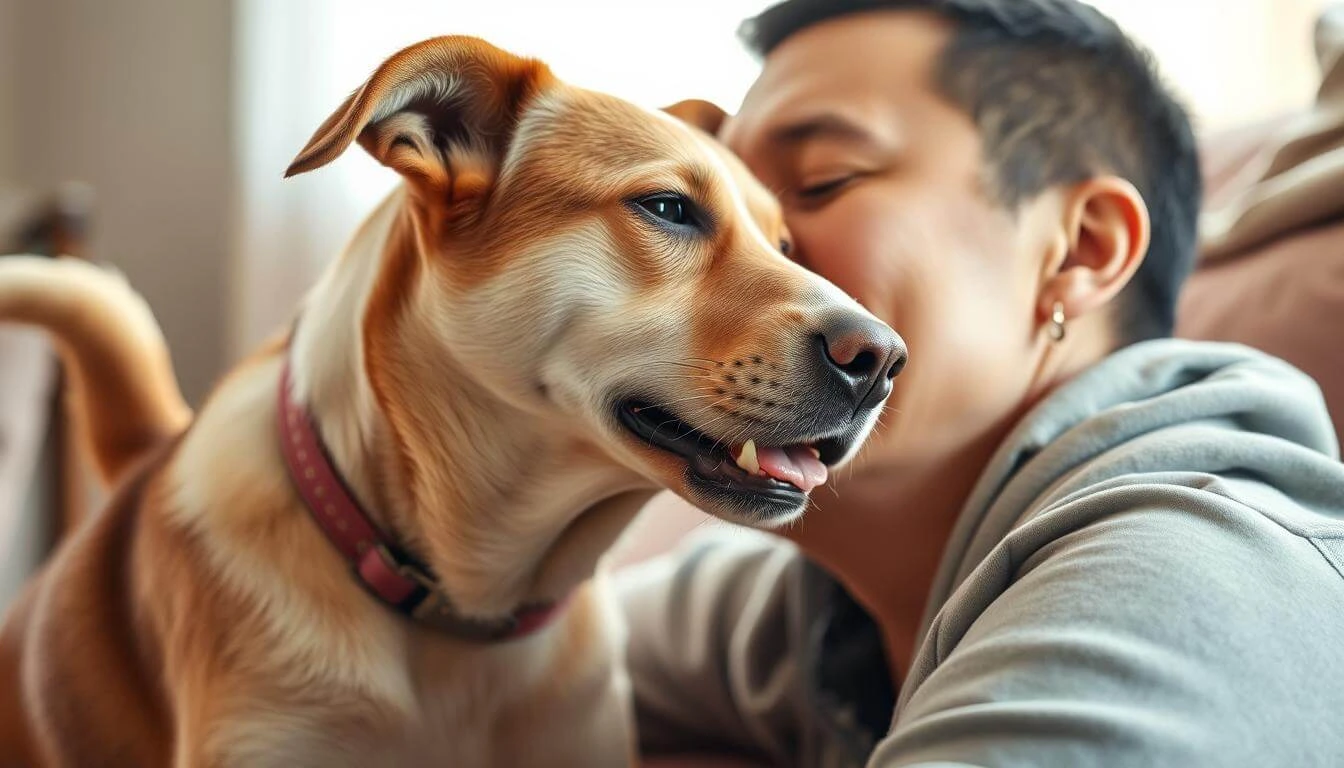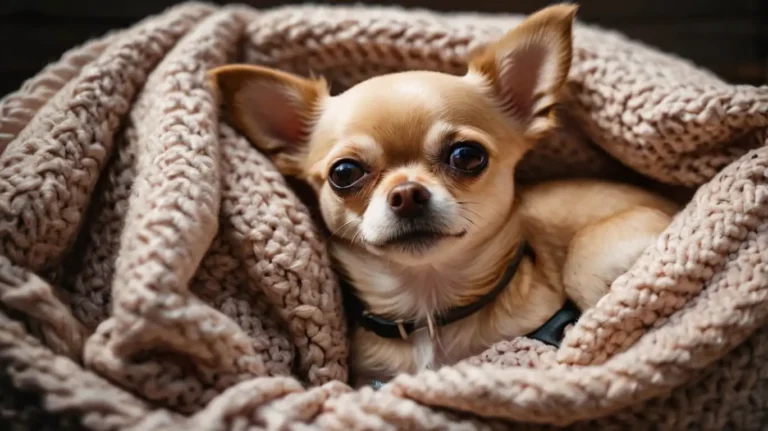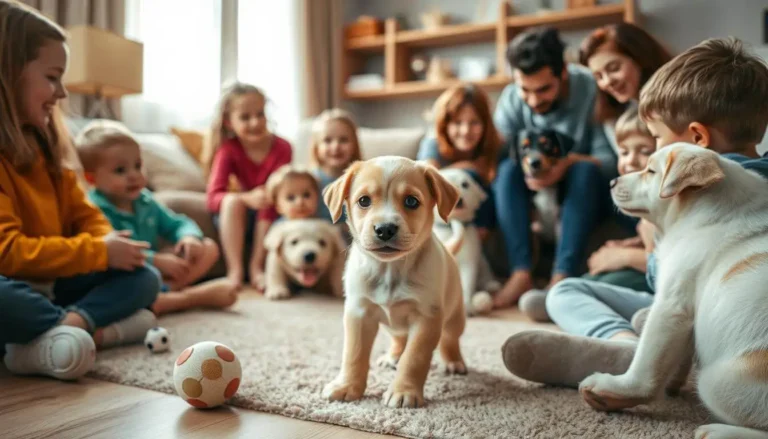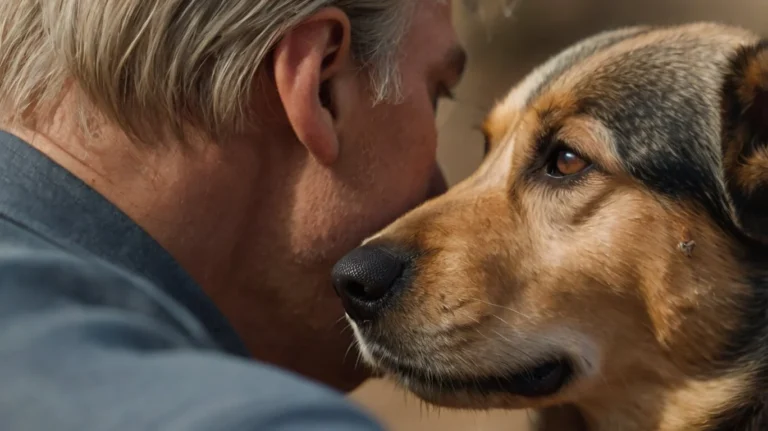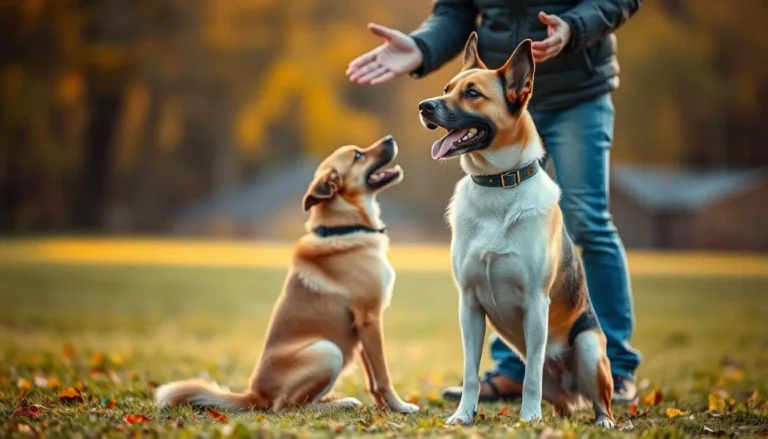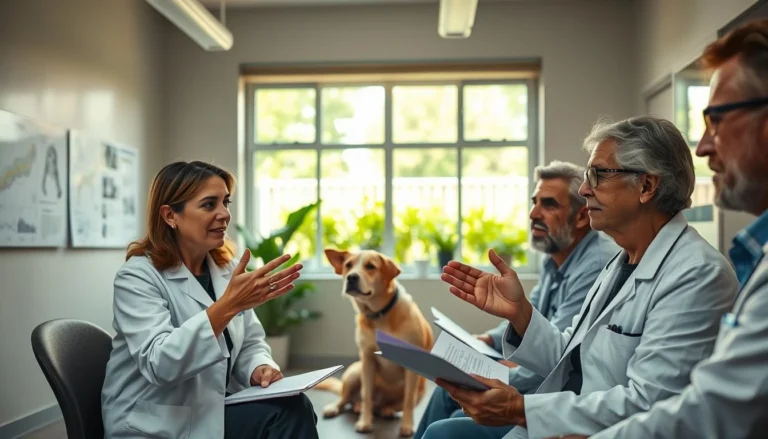5 Heartwarming Ways Dogs Say ‘I Love You’
“The majority of our pets’ brief existence with us is spent anticipating our daily return home, according to a dog lover.” This shows how deep the bond is between you and your dog. It’s about their loyalty and love. Knowing how dogs show love can make your bond stronger.
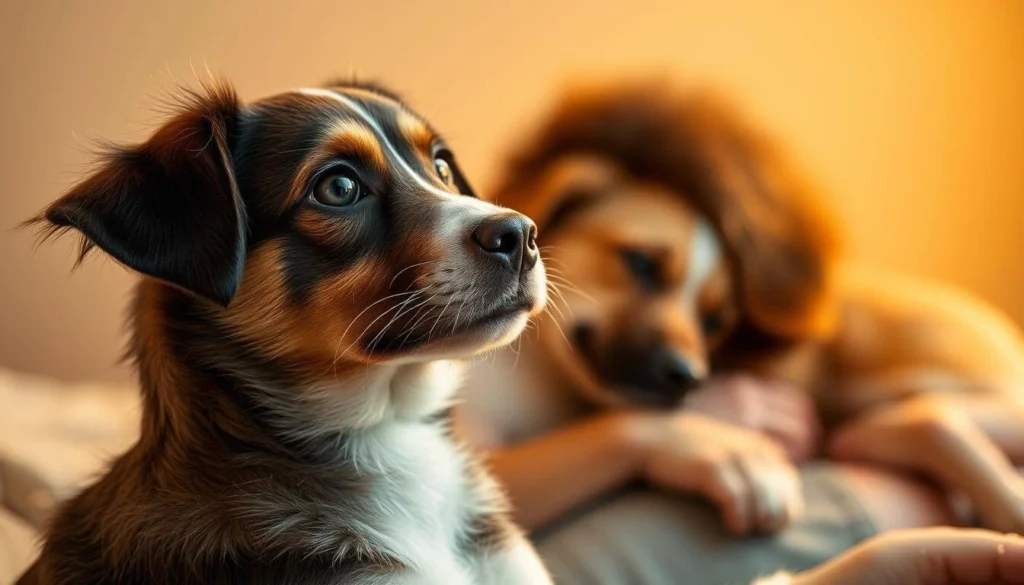
Your dog has learned to show love in special ways, not just with barks and wagging tails. As a dog owner, it’s key to understand and respond to these signals. Let’s look at the ways your dog shows love, so you can both enjoy a closer relationship.
Key Takeaways
- Dogs use various signals to communicate love.
- Understanding canine affection signals strengthens your bond.
- Dogs display their emotions through behaviors and actions.
- Recognizing your pet’s unique communication style is vital.
- Caring for your dog’s emotional needs fosters a supportive relationship.
Table of Contents
Understanding Canine Affection Signals
It’s important to know how dogs show love and affection. They use dog body language like postures and facial expressions. For example, a relaxed dog is happy and trusts you.
If your dog doesn’t look at you, it might be feeling shy or scared. Paying attention to these signs helps you understand your dog’s feelings. It makes your bond stronger and lets you meet their needs better.
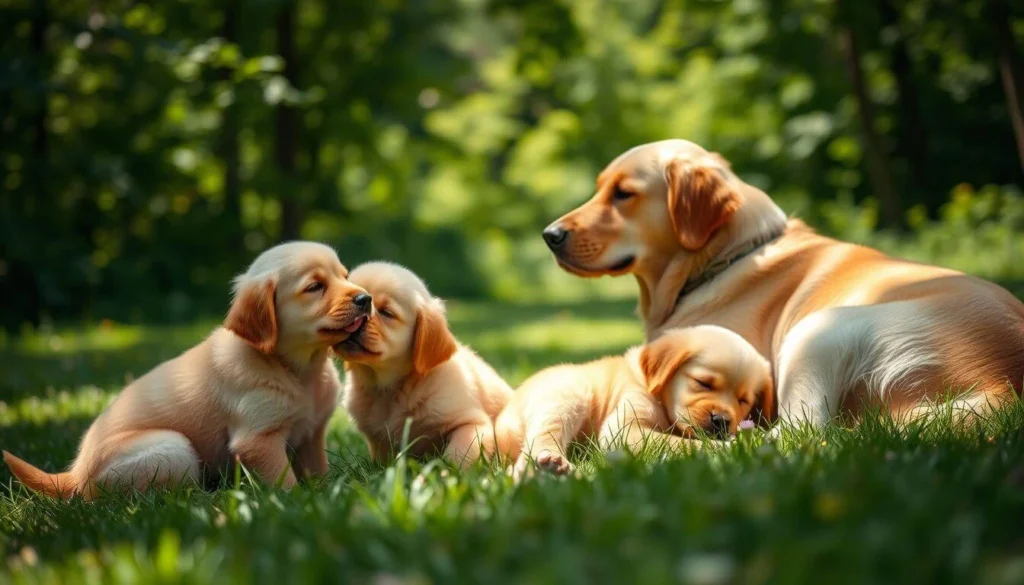
How Do Dogs Say ‘I Love You’?
Understanding how dogs show love involves recognizing their unique sounds and body language. Dogs use sounds and physical gestures to express their feelings. Each sound has its own meaning, and their posture can deepen your bond with them.
Unique Vocalizations of Love in Dogs
Dogs show love in many ways. High-pitched barks often mean they’re excited to see you. Whining can be a request for attention or a sign of happiness. A low growl usually means they’re content.
Knowing these sounds helps you understand what your dog is feeling. This way, you can respond in a way that shows you care.
Interpretation of Dog Body Language
Dog body language is key to understanding their emotions. A wagging tail usually means they’re happy to see you. Ears forward show curiosity or excitement, while relaxed ears mean they’re comfortable.
By paying attention to these cues, you can strengthen your bond with your dog. It’s a way to show them you care and understand them.
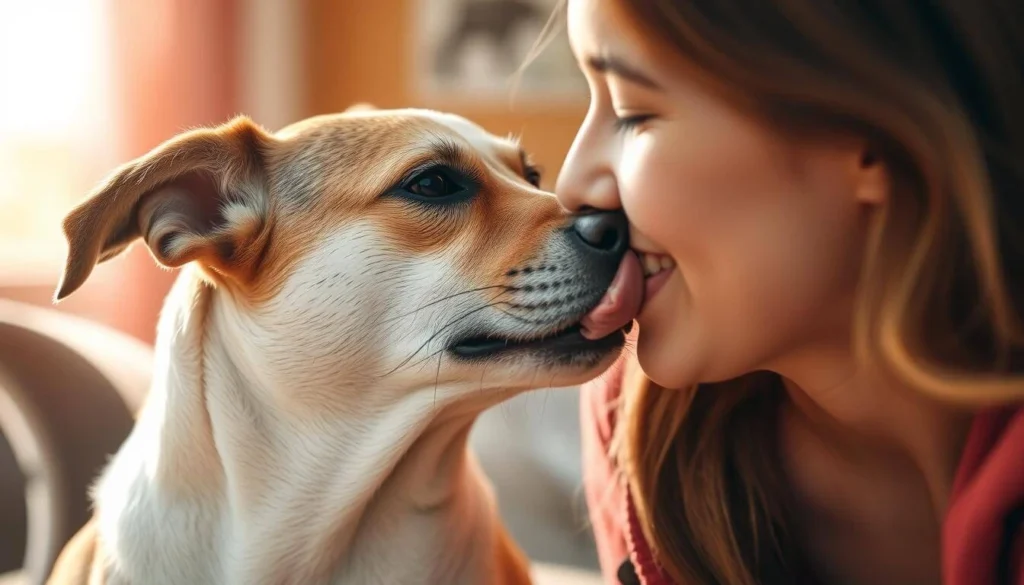
Expressive Gestures in Dogs
Dogs show their feelings through different gestures. These gestures help you understand what they’re thinking and feeling. Two key ways dogs express themselves are through tail wagging and eye contact.
Tail Wagging and Its Meanings
Tail wagging is a common way dogs communicate. But, it can mean different things based on how fast and how it’s held. A wagging tail usually means they’re happy or excited. But, a slow wag can show they care about you.
If a dog’s tail is stiff, it might be upset or worried. Paying attention to how they wag their tail can tell you a lot about their mood.
The Significance of Eye Contact
Eye contact is important for building trust with your dog. When they look at you gently, it means they feel safe and love you. This helps make your bond stronger.
Knowing the importance of eye contact helps you understand your dog better. It lets you know how they’re feeling and what they need from you.
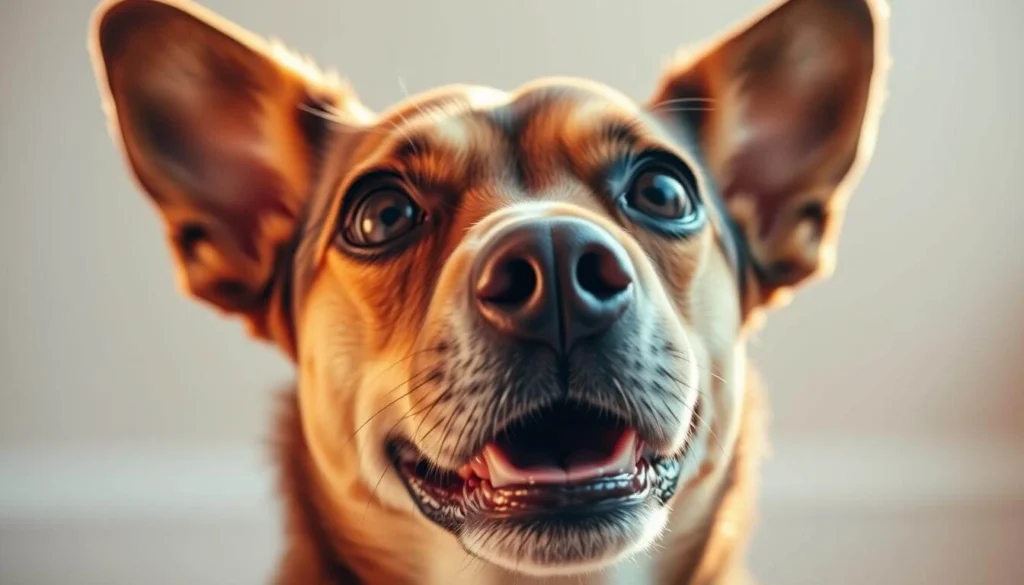
Physical Touch: The Canine Connection
Physical touch is key in how dogs show love. Cuddling strengthens your bond and makes both feel secure and comfortable. Dogs seek closeness to connect and share warmth. Understanding these interactions shows how dogs express love.
The Importance of Cuddling
Cuddling is a vital way to show love and trust. When your dog snuggles or nudges you, they feel safe and valued. This closeness deepens your emotional bond.
Cuddling also releases oxytocin, a hormone that brings joy and trust. It benefits your dog’s mental health and shows them you care.
How Dogs Initiate Play as a Sign of Affection
Playtime is a key way dogs show love. When your dog brings a toy or play bows, they want to play and show happiness and loyalty. These play moments strengthen your bond and trust.
Engaging in play helps you understand your dog better. It enriches your relationship and creates happy memories.
| Way Dogs Show Love | Description |
|---|---|
| Cuddling | Provides warmth, comfort, and a sense of security. |
| Nudging | Indicates a desire for attention and closeness. |
| Play Initiation | Reflects happiness, loyalty, and invites shared experiences. |
| Leaning | Shows trust and affection, often seeking comfort from you. |
Vocalizations: More Than Just Barking
Dogs express emotions in many ways, not just by barking. This section explores the different sounds dogs make. It helps you understand your dog’s feelings better. By recognizing these sounds, you can bond more closely with your dog and meet their needs better.
Understanding Your Dog’s Unique Sounds
Every dog has its own set of sounds to express emotions. Some common ones include:
- Yipping: Often shows excitement or playfulness.
- Whining: May mean distress, anxiety, or a need for attention.
- Growling: Can be a warning or a playful sign, depending on the situation.
It’s important to recognize these sounds to understand your dog’s emotions. You can learn to read their feelings by listening to their sounds and watching their body language.
How Your Dog’s Tone Reveals Feelings
The pitch and tone of your dog’s sounds tell a lot about their mood. For instance:
| Tone | Emotion |
|---|---|
| High-pitched bark | Happiness and eagerness |
| Low growl | Discontent or warning |
| Soft whine | Seeking comfort or affection |
Knowing your dog’s tone helps you respond to their needs better. By listening to these sounds, you can build a stronger emotional bond with your dog.
Decoding Dog Behavior for Deeper Understanding
Understanding your dog’s emotional world starts with decoding dog behavior. Every action they take can show us how they feel and if they’re happy. For example, when a dog tilts its head or wags its tail, these are important signs of their mood.
Spotting stress signals is key. Signs like panting, lip licking, or avoiding eye contact show they might be uncomfortable or anxious. But, when they roll over to show their belly or snuggle up, it means they love and trust you. These actions show positive dog emotions and strengthen your bond.
Knowing these subtleties in dog behavior lets you meet their needs better. When you understand their feelings and signals, your relationship with them grows stronger. It makes it easier to connect with your dog on an emotional level, creating a happy environment for both of you.
Ways Dogs Show Love Beyond Words
Learning how dogs show love can make your bond stronger. Their actions show they care and feel deeply, connecting with you in special ways. These signs of love also show they can understand and share human feelings, making your relationship even closer.
Caring Actions That Indicate Affection
Dogs show love in many ways. Here are some examples:
- Leaning against you: This shows trust and comfort.
- Bringing you their favorite toy: A sign that they want to share happiness.
- Following you around: This behavior reflects their desire to be close and involved in your life.
- Grooming behaviors: Licking or nudging can signal care and affection.
How Dogs Mirror Human Emotions
Dogs are amazing at mirroring human emotions. If you’re feeling down or stressed, they might snuggle closer or act gently. This shows they get how you feel.
Recognizing these signs can make your bond with your dog even stronger. It helps you understand their emotional needs better. This can lead to a lifelong connection with your furry friend.
Building a Stronger Bond with Your Dog
Creating a strong bond with your dog is key for their happiness and yours. Doing activities together strengthens your connection. Try different exercises and routines that make learning fun and interactive.
Activities That Enhance Your Connection
There are many ways to grow your bond with your dog. These include:
- Obedience training sessions that provide structure and understanding.
- Agility courses that challenge them physically and mentally.
- Regular playtime with toys to stimulate excitement and joy.
- Outdoor adventures, such as hiking or beach trips, for quality bonding time.
These activities make bonding fun and strengthen trust. They also improve communication. Regular training shows your dog who’s in charge while letting them be themselves.
Recognizing and Responding to Your Dog’s Signals
Understanding your dog’s signals can make your bond stronger. Watch their body language and listen to their sounds. Here are some common signals:
| Behavior | Meaning |
|---|---|
| Tail wagging | Happy and excited |
| Play bow | Invitation to play |
| Leaning against you | Seeking comfort and closeness |
| Soft eyes | Relaxed and trusting |
Showing love and care when you respond to these signals makes your bond stronger. By being part of their emotional world, you make your connection richer.
The Role of Routine in Dog Affection
Creating a routine is key to showing your dog love and security. It helps with feeding, walking, and playtime. This makes your dog feel safe and loved.
Having a routine builds trust and strengthens your bond. Dogs love routine and feel secure with it. Regular meals and exercise make them happy and affectionate.
Here are some key points for a dog routine:
- Regular feeding times make your dog excited.
- Daily walks keep them physically and mentally healthy.
- Playtime strengthens your bond and makes both of you happy.
- Consistent training shows respect and obedience.
| Activity | Benefits for Routine | Impact on Dog Affection |
|---|---|---|
| Feeding | Predictable meals secure their emotional wellbeing | Increases loyalty and trust in the relationship |
| Walking | Regular exercise encourages happiness | Builds shared experiences and reduces anxiety |
| Play | Fun and interaction enhance bonding | Strengthens your affectionate connection |
| Training | Establishing rules promotes good behavior | Fosters respect and closeness |
This structured approach shows your dog love and strengthens your bond. A daily routine in dog affection makes your interactions deeper. It helps you understand each other’s needs and creates a loving atmosphere.
Conclusion
Exploring how dogs show love reveals a deep bond between you and your pet. By understanding signs like wagging tails and body language, you can see how much your dog cares. This lets you strengthen your connection and meet your dog’s needs better.
Dogs show love in many ways, from playful to cuddly moments. Activities that bring you closer can make your bond stronger. This way, both you and your dog feel loved and understood.
By recognizing and showing love back, you build a lifelong friendship with your dog. Paying attention to your dog’s needs makes your life together joyful. It celebrates the unconditional love dogs share with us.
FAQ
How do dogs say ‘I love you’?
Dogs show love in many ways. They wag their tails, cuddle, and make sounds. They also show love through physical contact and play.
What are some common canine affection signals?
Signs of love include relaxed body language and gentle eye contact. A wagging tail at a moderate speed and leaning against you also show love. These actions mean they trust and feel connected to you.
How can I interpret my dog’s body language?
Watch your dog’s body language closely. A wagging tail usually means they’re happy. Ears pulled back might show they’re feeling scared or uncomfortable.
What vocalizations indicate affection in dogs?
Dogs bark or whine to show they’re excited and loving. A low growl can mean they’re content. Each dog’s sounds can tell you how they’re feeling.
Why is eye contact important in dog communication?
Eye contact is key for trust and a strong bond. It shows respect and love when you’re together.
How does physical touch contribute to canine affection?
Touch like cuddling and petting makes dogs feel safe and close. They often want to touch you, showing they want to be near.
In what ways do dogs show love beyond vocalizations?
Dogs show love in many ways. They protect you, mirror your feelings, and play with you. For example, they might guard you or snuggle when you’re sad.
How can I strengthen my bond with my dog?
Doing activities together builds trust and communication. Showing you care about their love signals makes your bond stronger.
What role does routine play in dog affection?
Routine makes dogs feel safe and loved. Regular times for food, walks, and play strengthen your bond. It shows them you care and are there for them.

